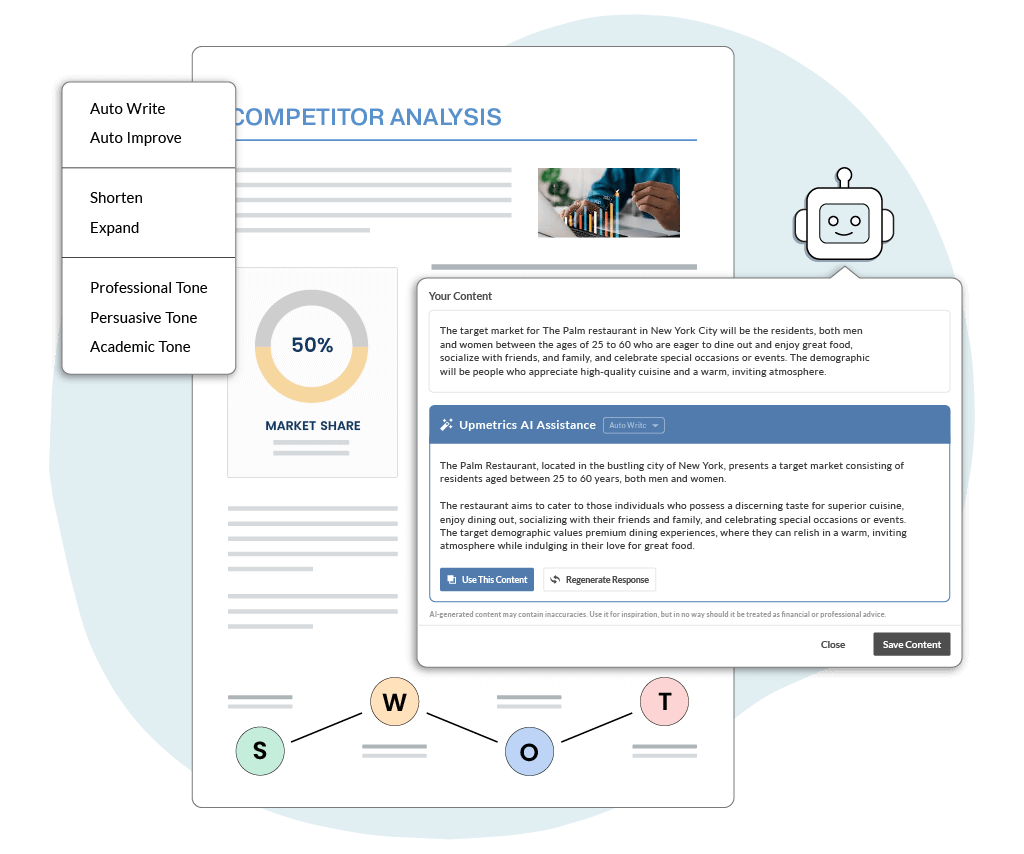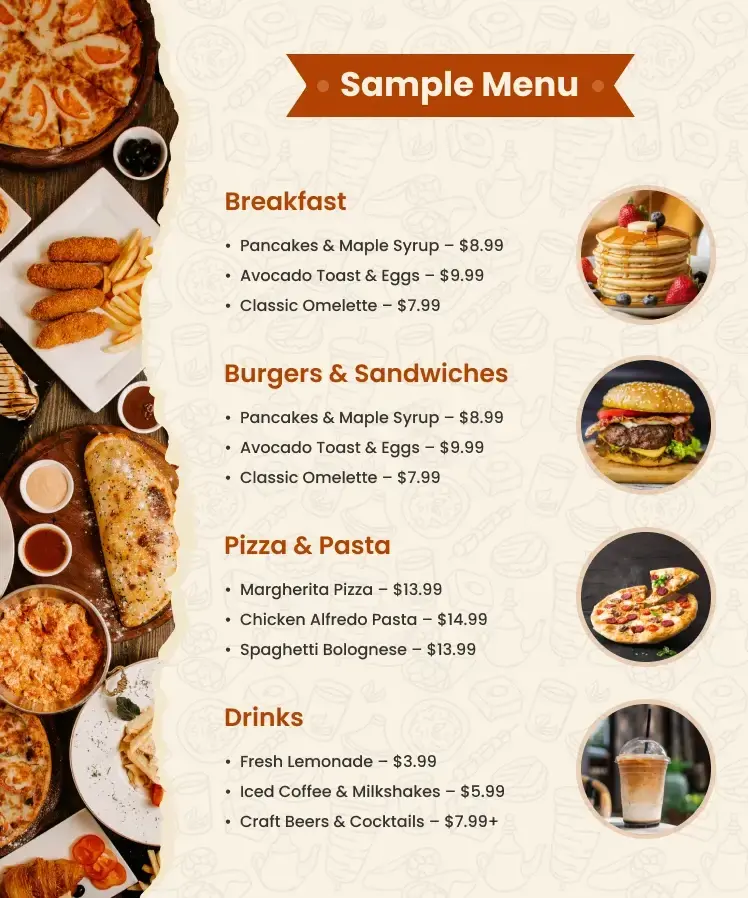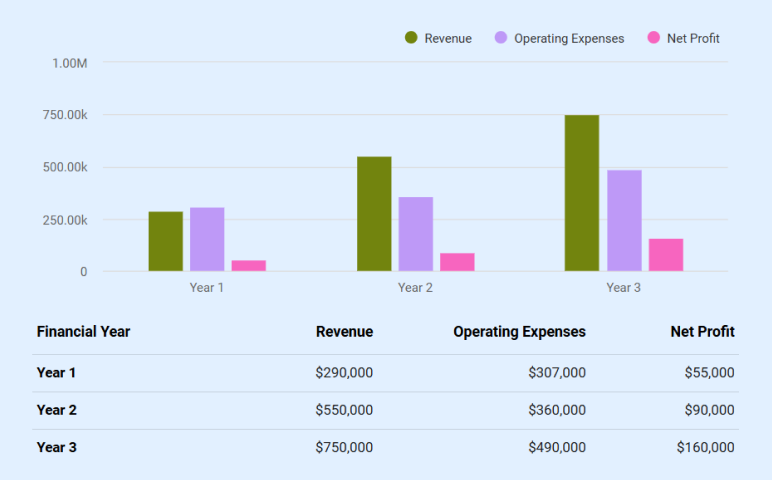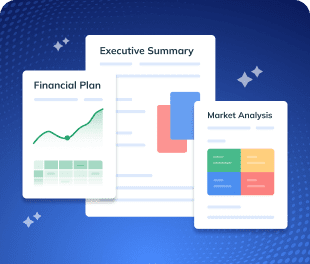So you’ve got a restaurant idea. Maybe you’ve even picked a name that sounds cool and tried out a few dishes on friends. Great!
But before you start designing the space or stalking vintage cutlery on Instagram, there’s one thing you really need: a solid business plan. One that helps you figure out what it’ll cost, how it’ll run, and how to avoid running out of money.
Wondering how to draft a plan?
Don’t worry! This restaurant business plan template makes it simple. It covers everything that you need to get your restaurant off the ground.
Key Takeaways
- Highlight the concept of the restaurant along with the ambiance, types of cuisines, customer base, and USPs of the restaurant in the plan.
- Utilize tools for SWOT analysis to assess your strengths, weaknesses, opportunities, and threats for making informed decisions.
- Craft an impactful executive summary that outlines your restaurant’s concept, marketing approach, financial outlook, and team expertise to attract potential investors and partners.
- Conduct thorough market research to understand market trends, consumer preferences, and the needs of your target market.
- Analyze the competitive landscape, and identify direct & indirect competitors, to develop strategies that maintain your restaurant’s competitive advantage.
- To ensure efficient daily operations, provide in-depth operational plans that incorporate staffing, additional services, inventory control, and customer service.
- Create realistic financial projections for sales revenue, expenses, and profit forecasts while considering contingencies & emergencies.
Why you need a restaurant business plan
Crafting a restaurant business plan is daunting but its significance cannot be underestimated. It is essential to drive your business toward success.
In the competitive atmosphere where there are 700,000+ restaurants in the USA, having a proper plan will help you get funding and better adaptability in a constantly changing business environment.
Here are a few more reasons why having a business plan matters:
- Clarifies your vision and turns your idea into clear, actionable steps
- Sets realistic goals by defining costs, pricing, and revenue targets
- Helps secure funding by showing investors and lenders that you’re prepared
- Plans for challenges like rising food, labor, and operating costs
- Supports decision-making for daily operations and long-term strategy
- Keeps you competitive and helps you stand out in a crowded market
In short, it’s like your go-to guide for keeping every part of the business on track.
How to write a restaurant business plan: Step-by-Step Guide
Since we are talking about a restaurant business plan; let us walk you through this restaurant business plan outline step-by-step without any delay:
1. Executive summary
An executive summary is the first section and the most significant section of any business plan. It captures the essence of your whole plan summarizing it for a quick understanding of your business.
Think of it as a sneak peek for the readers that draws their attention to the entire restaurant business plan.
You should start your summary with a compelling introduction with the name of your restaurant. It should also focus on the essence of your restaurant concept.
Give a brief overview of your unique selling points, emphasizing what makes your restaurant special. It might be the signature dishes, innovative ambiance, prime location, or some new cuisine experience.
Apart from the above essential points, your executive summary should include:
- Mission statement
- Vision statement
- Execution structure
- Potential costs
- Expected return on investment
Many readers will read the executive summary before making a judgment, so if this is all they read, make every word count.
Also, SBA advises to include financial projections in your executive summary if you’re using your business plan to request funding.
Say goodbye to boring templates
Build your business plan faster and easier with AI
Plans starting from $14/month

2. Company Overview
Company overview is a part where you fully introduce your restaurant business including legal business structure, location, and your restaurant’s proposed concept.
Here you have the liberty to be a little more creative in describing your restaurant in the whole business plan.
Here are some points to incorporate in the company overview:
- Detailed vision and mission statement
- Type of restaurant (fine dining, small restaurant, bistro, cafe, etc.)
- Legal business structure
- Service style
- History and background of the restaurant (if existing)
- Owners’ names and qualifications
- Cusinies & menu highlights
- Restaurant size and seating capacity
- Operating hours & meal plans
- Ambiance
- Related service availability (delivery, catering, etc)
Mainly emphasize the chosen location because easily accessible locations with high foot traffic will attract more walk-in customers. And if you haven’t decided on a specific location yet, then mention the type of place you are looking for to give an idea about it to your readers.
Besides, mention the short-term and long-term goals of your restaurant business in the later part of the company description. Along with that mention regional industry trends and your USPs.

Pro-tip
Need Assistance Writing a Restaurant Business Plan?
Get Upmetrics’ business plan template, import data directly into the editor, and start editing using Upmetrics AI Assistant.

3. Market analysis
The market analysis section provides you with a clearer picture of your target market, competitors, and industry trends.
Based on the above details, one can make informed decisions while creating strategies. Therefore, make this section precise and concise to understand.
Here are some steps to follow to write an engaging market analysis section of the restaurant business plan:
- Define your customer base: Identify and describe whom you are going to serve. Make a consumer base after considering the demographics, location, and concept of your restaurant.
- Competitive analysis: List out the names of other restaurants in your location and do the SWOT analysis. You can get the competitive advantage of your restaurant this way.
- Market trends: Discuss any shift in consumer behavior like healthy choices, an increase in vegan food consumption, or technological breakthroughs that might affect your restaurant.
Consider conducting market research, TAM-SAM-SOM analysis, and SWOT analysis to get insights for this section.
Remember, this section helps your readers and potential investors understand your target market, restaurant market overview, market size, and growth potential, so make sure you play your cards right.
4. Sample Menu
The most vital step in launching your restaurant business is the menu. A well-curated menu design will sell itself for your restaurant. Even if you are a new restaurant, then present the sample menu with the name and logo of your restaurant on it.
The menu will showcase all the unique offerings your direct competitors might not provide. Not just the list of cuisines but the pricing is also crucial. This way potential investors and readers can understand your restaurant’s target price point.
Plus your menu should be in sync with target customers; for example, a restaurant near the university should contain more beverages and delicious food options for brunch as students prefer those things more.
Consider your menu as a part of branding, choose the same theme for the menu as for the restaurant.

5. Restaurant Design
Restaurant design is the part where you can show your restaurant concept to potential investors and readers practically. Moreover, create a mood board to explain things smoothly.
Utilize this section to show the uniqueness of your restaurant, and how it is different from competitors.
Explain how your design represents your restaurant’s branding and visual identity. Furthermore, mention how your target market will enjoy and appreciate the ambiance you plan to provide.
Note that restaurant design is one of the key elements to running a successful restaurant, so match the theme and cuisines accordingly.
In this section, you also have to provide a detailed description of how many seats are going to be there along with the floor plan of your restaurant.
6. Management Team
As the name suggests, the management team section of your restaurant’s business plan introduces restaurant owners, key executives, and the management team. It also incorporates the experience, qualification, and restaurant industry knowledge of every individual who is on the team.
A strong management team section can be essential to weigh authority and help potential investors be confident about your restaurant’s idea and vision.
You might consider including the following information in the management team section:
- Business owner or founder’s information
- Executive chef and culinary team
- Front-of-house manager
- Operations and back-of-house team
- Advisors/consultants
- The organizational structure of the team
Showcase how each member fits and what roles & responsibilities they will play. You should include a resume-styled summary for each person in the restaurant’s management section.
7. Operations Plan
The operations plan section outlines the daily business processes and activities centered on achieving the restaurant dream and objectives described in the rest of the plan.
A detailed operations plan helps you and your team define your responsibilities, daily tasks, and short-term goals you need to achieve, keeping track of your long-term objective.
Here are a few key elements to include in your operations plan section:
- Staffing and training
- Operating hours
- Operational process
- Tools and equipment
- Inventory control
- Technology and software
- Quality control measures
- Customer service policies
Remember it should incorporate all important daily tasks. Also, an operations plan is a living document, you can change it often according to the change in the dynamics of the work.
Read More: The Ultimate Guide to Restaurant Operations Planning
8. Marketing Plan
Even with great food, prices, and ambiance, you won’t attract enough diners without marketing.
Thus, a well-crafted restaurant marketing plan is necessary to spread awareness and build a strong brand presence.
The marketing plan can help you streamline your marketing efforts and create impactful and effective marketing campaigns while keeping track of the projected budget and maximizing return on investment.
Hence, this is the section in which you give an idea to your potential investors about how you will acquire new customers and retain existing ones. This section should include:
- Target market and their dining habits
- Branding and positioning
- Marketing strategies (website, social media accounts, etc.)
- Marketing Calendar
- USPs of your restaurant (unique ambiance, amiable staff, new cuisines in the local area)
- Your marketing goals
- Customer retention strategies (loyalty program, giving coupons or discounts on bulk orders or events)
Even if you are going to hire a PR agency for marketing, then mention it and the reason why you chose them.
After taking care of marketing, let us move further to finances.
Read More: Step-by-Step Guide to Restaurant Marketing Plan
9. Financial Plan
The financial plan of restaurant is the most crucial and demanding section of any business plan. It is one of the deciding factors for potential investors, banks, or any financial institute to invest in your restaurant business.
This section of your plan details your restaurant’s financial information and how it will reach its financial goals or how much revenue potential it has.
Here are key components and statements that you should include in your financial plan section:
- Startup costs: Break down everything you’ll need to open, from lease deposits, licenses, and renovations to equipment, furniture, initial inventory, and technology.
- Sales projections: Estimate revenue based on your seating capacity, menu prices, expected daily covers, and share of takeout/delivery orders
- Operating expenses: Plan for costs like ingredients (typically 28–35% of sales), payroll, rent, utilities, marketing, and tech systems such as POS and online ordering.
- Profit and loss forecast: Detail expected income and expenses over the next 3–5 years to show when you’ll be profitable.
- Cash flow statement: Map monthly cash movements so you’re prepared for slower seasons or unexpected costs.
- Balance sheet: Summarize your assets, liabilities, and owner equity to give a snapshot of financial health.
- Break-even analysis: Clearly show the sales level you need to cover all costs.
If you’re looking for investors or loans, specify how much you need and exactly how you’ll use it (build-out, staffing, marketing, working capital).
Putting these numbers and projections together can feel overwhelming, so it’s important to present them clearly. Using charts and graphs can make them much more understandable and visually appealing.
For example, here’s one generated with Upmetrics:

We hope that this sample restaurant business plan will provide you with an idea for writing a successful plan.
Restaurant Industry Highlights 2025
Here’s what the latest data tells us about the restaurant industry:
- Market size: The restaurant industry is big business. In 2025, the U.S. market is projected to reach $1.29 trillion, representing about a 7% increase over 2024. Meanwhile, the global market is expected to be valued at approximately $4.03 trillion.
- Employment: About 15.9 million people are expected to be employed in U.S. restaurants in 2025, with roughly 200,000 new jobs projected to be added this year.
- Profit margins: The average restaurant profit margin is about 3-5%, with food costs typically around 28–35% of revenue.
- Ghost kitchens: Delivery-only “cloud kitchens” keep expanding, valued at about $72.34 billion globally in 2025.
- Digital and delivery: Online ordering reached $380 billion worldwide in 2024 and is growing over 9% each year. Delivery now makes up roughly 41% of total restaurant revenue globally.
- Tech use is rising: About 79% of diners want restaurants to offer mobile ordering and payment options, making convenience a key part of the dining experience.
How to Refine & Present a Restaurant Business Plan
Once you have written your entire business plan, it is time to read and re-read it and make it error-free. You have to be confident about every aspect of the plan before you present it in front of your audience.
Moreover, alter your plan to suit different audiences to enhance your communication. For instance, keep your plan professional and include all the growth potential, profitability, and ROI data when you present your restaurant business plan for seeking funding.
Also, when you present your restaurant business plan to potential partners or vendors, emphasize collaboration benefits and how it can help in their individual growth.
Apart from the above points, make sure your plan has various engaging visuals, interactive elements, and enhanced storytelling to present all the data interestingly. Thus, make a digital presentation of your plan to incorporate all the above things clutter-free.
Once you are confident, it is time to email your plan to the people already on your mind. And give a pat to yourself for finally taking that step.
Download a sample business plan for a restaurant
Ready to kick-start your business plan writing process? And not sure where to start? Here you go, download our free restaurant business plan pdf, and start writing.
This intuitive, modern, and investment-ready template is designed specifically for restaurants. It includes step-by-step instructions & examples to help in creating your own restaurant business plan.
Discover how Upmetrics can help you write a business plan
With Upmetrics, you will receive step-by-step guidance, customizable templates, 400+ sample business plans, and AI assistance to streamline your business planning process.
In fact, if you are not adept with finances, the financial forecasting tool Upmetrics provides will help you create realistic financial forecasts for 3 or more years.
Whether you’re starting a new venture or looking to grow one, Upmetrics offers the resources and insights you need to develop a successful & professional business plan that aligns with your goals.




